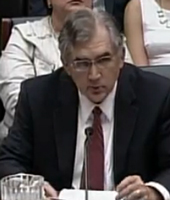Increased ethanol production has been good for corn growers, bad for poultry producers, but has overall helped increase farm income to record levels according to some testimony given in a House hearing on the Renewable Fuel Standard (RFS) this week.
 “The Renewable Fuel Standard is doing exactly what it was intended to do,” said National Corn Growers Association President Pam Johnson of Iowa. “It has positively impacted the agriculture sector by creating jobs and promoting rural development, reducing greenhouse gases and allowing our nation to grow our energy at home.” Pam Johnson Testimony
“The Renewable Fuel Standard is doing exactly what it was intended to do,” said National Corn Growers Association President Pam Johnson of Iowa. “It has positively impacted the agriculture sector by creating jobs and promoting rural development, reducing greenhouse gases and allowing our nation to grow our energy at home.” Pam Johnson Testimony
 National Chicken Council (NCC) Senior Vice President and Chief Economist Bill Roenigk said at the hearing that poultry producers have struggled with rising feed costs. “Since the RFS was implemented in October 2006, the feed costs for chicken, turkey and eggs have gone up $50 billion,” he said. “More troubling than the higher costs is the volatility and trying to outguess the market.” Bill Roenigk Testimony
National Chicken Council (NCC) Senior Vice President and Chief Economist Bill Roenigk said at the hearing that poultry producers have struggled with rising feed costs. “Since the RFS was implemented in October 2006, the feed costs for chicken, turkey and eggs have gone up $50 billion,” he said. “More troubling than the higher costs is the volatility and trying to outguess the market.” Bill Roenigk Testimony
 Purdue University agricultural economist Chris Hurt told the hearing that farm income and land values have risen dramatically since implementation of the RFS. “Higher farm incomes on crop farms benefited rural communities as that higher income spread through local purchases of farm and consumer goods and services,” Hurt said. “In addition, expansion of the ethanol industry in rural communities added some employment and related economic activity.” While feed costs have increased and the crop sector has done better than livestock, Hurt said the livestock industries appear to in a recovery phase. Dr. Chris Hurt Testimony
Purdue University agricultural economist Chris Hurt told the hearing that farm income and land values have risen dramatically since implementation of the RFS. “Higher farm incomes on crop farms benefited rural communities as that higher income spread through local purchases of farm and consumer goods and services,” Hurt said. “In addition, expansion of the ethanol industry in rural communities added some employment and related economic activity.” While feed costs have increased and the crop sector has done better than livestock, Hurt said the livestock industries appear to in a recovery phase. Dr. Chris Hurt Testimony

